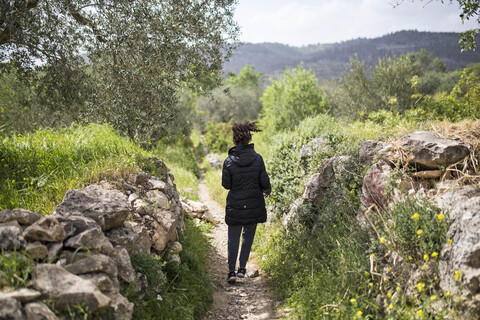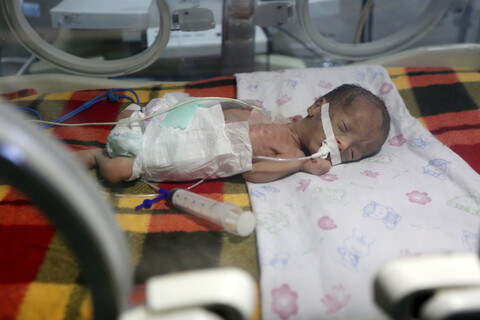The Electronic Intifada 14 June 2023

Ahmad al-Bazz and Raed Khatib, 50, a Palestinian refugee from Kafr Saba who works at the Yafa Cultural Center, put up al-Bazz’s photos in Balata for the first of 17 exhibits in West Bank refugee camps.
Photographer Ahmad al-Bazz was asking questions of himself as he placed a large bucket of homemade glue in the trunk of his small white Fiat parked in front of his Nablus home.
“I can’t believe I stayed up until 3 am to make this glue! Will it work? Should I buy the silicon glue? But this is an Israeli product.”
He was unsure of the quality of the glue he had made for the first time – using flour, water and sugar from a tutorial he found on the internet. It was 8 am and he had an appointment at the Yafa Cultural Center in Nablus’ Balata refugee camp to kick off a four-day photo exhibition in the streets of refugee camps in the West Bank.
“It does not make sense to exhibit this work in the cities or internationally before taking it to the [former] residents of these depopulated places,” al-Bazz said.
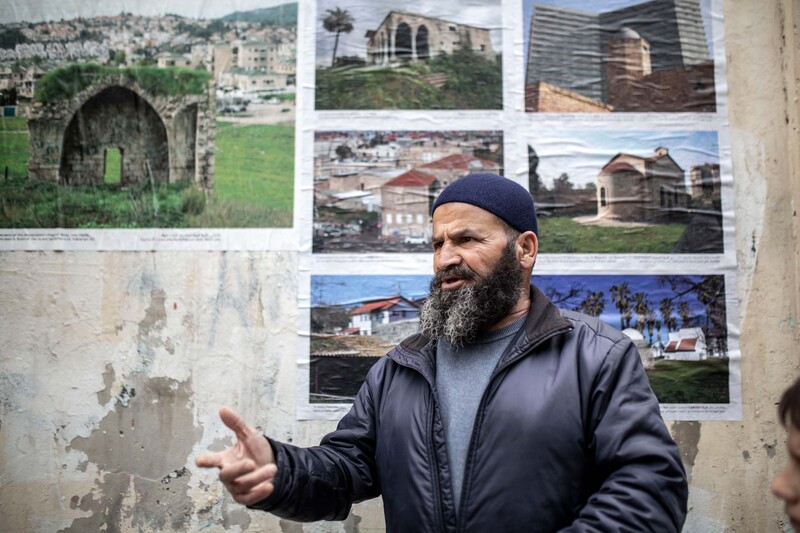
Aged 67, this man said his family was from Menashiya, a depopulated neighborhood of Jaffa.
The Nakba 75 exhibition – which started in Nablus on 6 May and ended in Jenin on 9 May – comprised photos of what remains of Palestinian villages that were ethnically cleansed by Zionist militias in the period surrounding the creation of the state of Israel.
In 1947-49, more than 500 Palestinian villages were destroyed and some three-quarters of the Palestinian population – between 750,000 and 1 million Palestinians – were killed, expelled at gunpoint or otherwise forced to flee.
Palestinians refer to this period as the Nakba, “disaster” or “catastrophe” in English. This year marked its 75th commemoration. Today, the Palestinian refugee population numbers more than 6 million.
Some live just dozens of kilometers from their original villages in impoverished and crowded refugee camps in the West Bank and Gaza Strip.
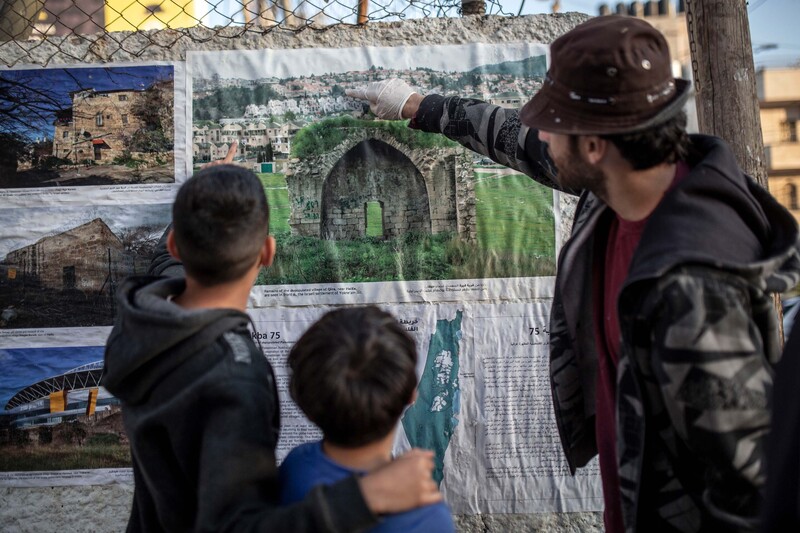
Al-Bazz explains a photo to children in the Qalandiya refugee camp, near Ramallah.
Over a period of two years until the beginning of 2023, al-Bazz – who holds a West Bank ID but has a military-issued work permit to enter inside 1948 boundaries – visited over 200 depopulated villages.
“It was a dream for me to go around ‘48 Palestine. You always hear about it and I was asking myself: how can I travel to the US, to the UK, to Germany, but not to Haifa?”
That dream came true. But while the trip was first and foremost personal, al-Bazz is a photographer. So he took photos.
“I wanted first to educate myself. In the process, I collected tons of images,” al-Bazz said. And he was shocked to find, despite him already knowing it, how real the Nakba is.
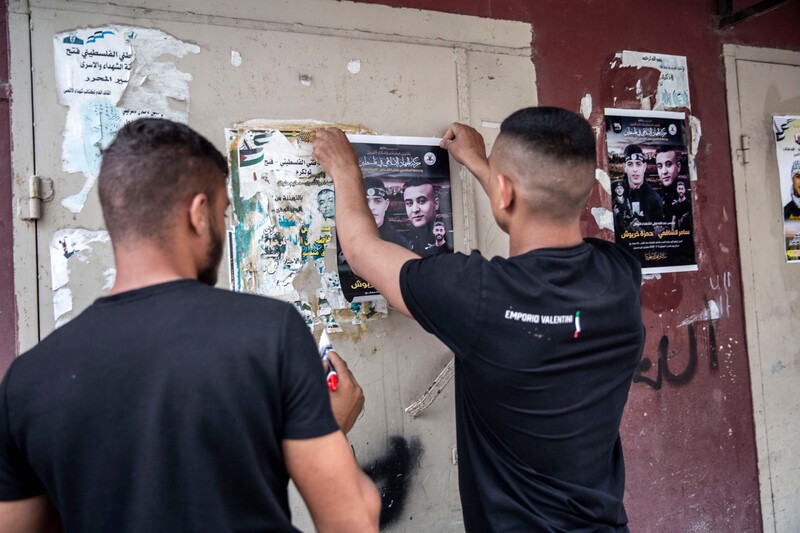
Two youths plaster posters of two Palestinians slain by the Israeli military. Hamza Kharyoush and Samer al-Shafei, both 22, were killed in Tulkarm in early May, a day before al-Bazz’s exhibition went up.
“It’s not a rhetorical thing to keep saying Nakba, Nabka,” al-Bazz insisted. “The Nakba is real.”
Balata is the biggest refugee camp in the West Bank. It is a hotbed of resistance to the Israeli colonial regime and military occupation. As a result, one of the main challenges for the exhibition was to find suitable empty space. In every refugee camp, walls are filled with political slogans and posters of those who have been killed by the Israeli military. And al-Bazz was adamant he would not have these removed for his exhibition.
Still, an empty wall needed to be found. Al-Bazz did not want to display the exhibit at any center, any official Palestine Liberation Organization committee building or at any public opening or event. It was a political choice.
“How could I co-organize events with these institutions, which gave up on the same places I am showing in this exhibition,” al-Bazz said, alluding to widespread anger at the PLO and Palestinian Authority leadership for allowing a pursuit of a two-state outcome to overshadow and eclipse the pursuit of refugees’ right of return to their homes and lands.

A child helps al-Bazz set up his exhibition in Al-Aroub camp, between Bethlehem and Hebron.
Some small coordination with local popular committees affiliated with the PLO in the camps was nevertheless necessary to find suitable locations and to facilitate contacts with the local communities.
In the Jenin refugee camp, for instance, while PLO and Fatah officials held speeches in front of the photos, al-Bazz stayed in the background and refused to be associated with the event. The priority for him was to directly reach people in the streets while avoiding political parties and institutions.
Back in Balata, the concerns were of a more practical nature. “Should we put up the big photo first or the A3s?” al-Bazz wondered aloud. Once a wall had been chosen, it was a matter of applying the homemade glue for 30 A3 pictures and one large map of the depopulated villages, complete with captions in both Arabic and English identifying and describing each location.
Al-Bazz was not totally happy with the adhesive glue, which caused some photos to wrinkle, and he tried hard to smooth them out with his sleeve.
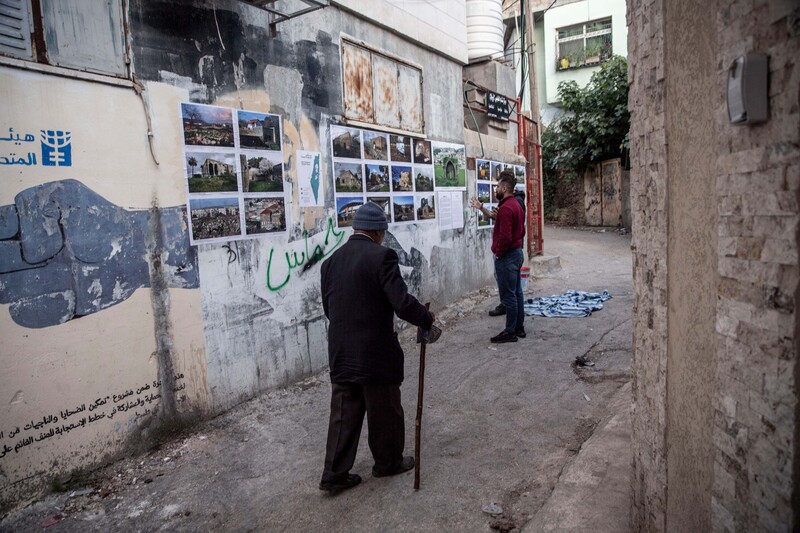
An elderly refugee passes by the Nakba 75 exhibit in the Deheisheh camp.
It was still early in Balata camp but some curious passersby stopped anyway.
Dina Habash, originally from the depopulated village of Beit Dajan, looked through the photos but couldn’t find her village.
Born in Balata, she said she had managed to visit her village just before the COVID-19 pandemic hit, and that she found the home of her grandfather.
“The olive and fig trees are still standing. We found the door a bit open so we rang the bell and entered. Some people came out and looked a bit afraid, but I told them this was my grandfather’s home, and asked if we could enter.”
The woman who answered the door – a Jewish family had been moved into the home, as had happened in all buildings that had been depopulated but not destroyed – asked Habash what she meant, Habash recalled.
“We told them it means that this is our home, not yours. [The Jewish woman] said that was not their fault: ‘They [the Israeli government] gave us this home, and we will not get out of here. This is mine.’”
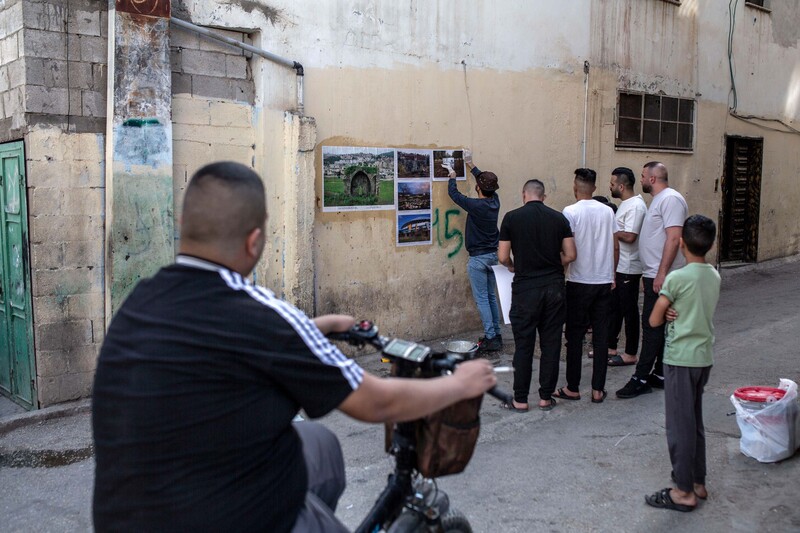
A small crowd gathers round al-Bazz as he puts up his photos in Far’a camp.
Seeing the photos of the depopulated villages made her “heart cry,” Habash said.
“We remember our past, our ancestors. And our children still live this Nakba,” Habash said before she went on her way.
Ousama Mustafa, 49, from the depopulated village of al-Tira, said the pictures provoked in him a mixture of “sadness and anger.”
Born in Balata camp, Mustafa never had the chance to visit his village.
Another passerby, who did not want to be identified, was affected differently: “It gives me the desire to fight. Did anyone take back their stolen land without force?”
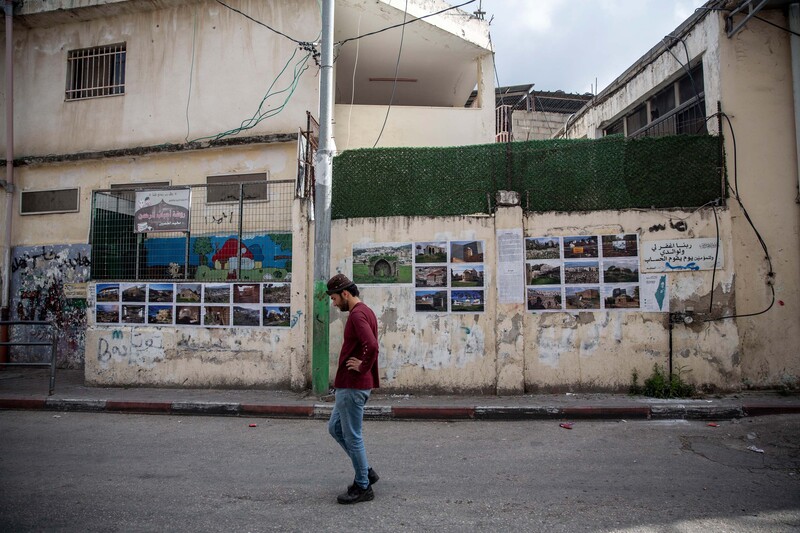
Al-Bazz ponders his exhibit in the Jalazon refugee camp.
After an hour and a half, al-Bazz took a step back to look at his work. Then he made a phone call to a contact in the Askar refugee camp, also in Nablus, to start coordinating the next exhibit.
Over the following four days, al-Bazz exhibited in another 16 camps in the West Bank, from the Tulkarm camp in the north to al-Fawwar camp south of Hebron. He also organized exhibitions in three other locations: a cafe in Ramallah, on the Separation Wall in Bethlehem and in a school in Deir Ammar village near Ramallah.
The process was exhausting. The sun and heat made it feel like summer. The air in the camps was filled with pollution and dust – an UNRWA employee strike meant that trash had piled up in the alleys.
There was also palpable tension. Israeli military raids into refugee camps are common, and residents can be suspicious of newcomers. When arriving in Aqbat Jabr camp in Jericho – recently the site of repeated military incursions – al-Bazz asked directions to the home of his contact person from a passerby. He was asked in return to identify himself.
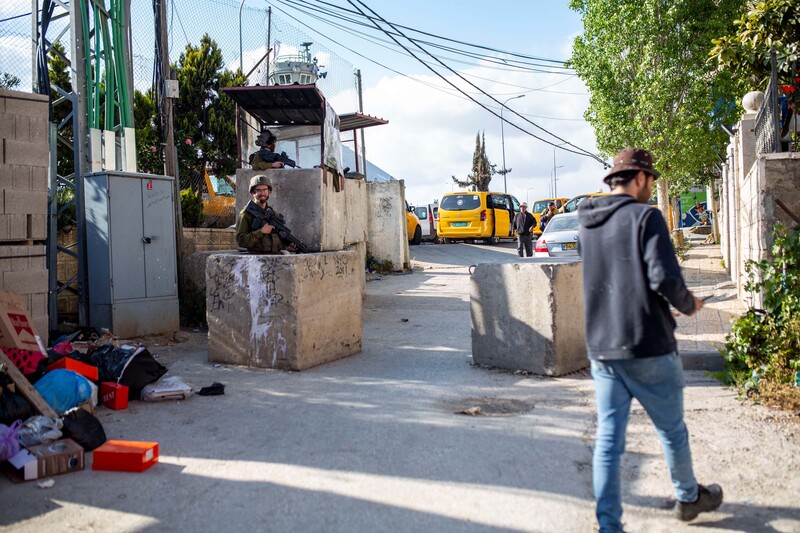
Soldiers man a checkpoint at the entrance of Al-Aroub refugee camp in the southern West Bank between Bethlehem and Hebron.
Al-Bazz was not bothered. He understands the need for Palestinians to be cautious about who enters the camps. He showed his press card. Two days before this, Israeli special forces had raided Nablus, some of them disguised as women and assassinated three Palestinian fighters.
In Nur Shams camp, the exhibition was put up only a few meters away from a checkpoint manned by Palestinians. Piles of sandbags were strewn on the side of the small road, ready to be placed across the street at night to make any Israeli incursion more difficult.
In the Jenin camp, also the site of repeated Israeli military incursions, al-Bazz arrived to find the camp completely blocked by resistance groups.
“Imagine, they see a strange guy with a hat and his car full of stuff. I had to call my contact to get me,” explained the photographer.
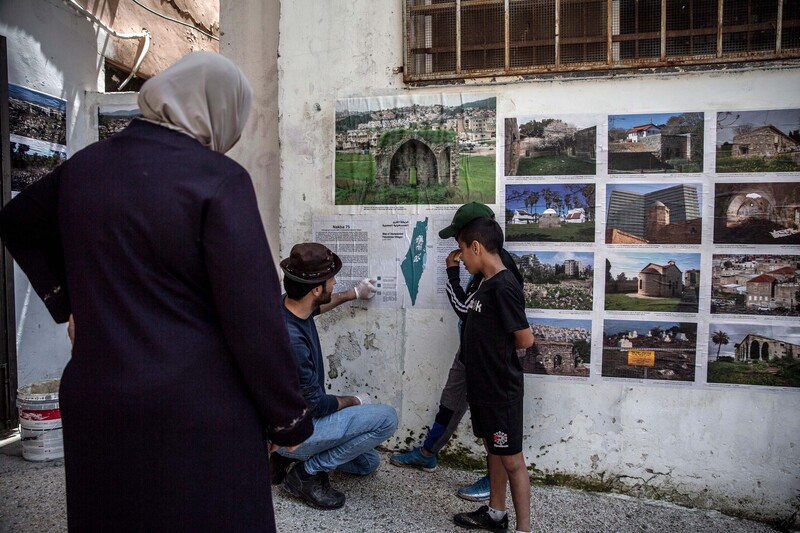
Raeda Masri watches al-Bazz explain his map to two children. She was looking unsuccessfully for pictures from her village, Salameh.
Reactions to the exhibit were not always positive. An older man in Far’a camp near Nablus was singularly unimpressed.
“So what?” he asked, refusing to give his name. “Will those photos change anything for us? Will they give us our right of return?”
Others were more appreciative. People came to find their old homes, and some were disappointed not to see their villages depicted. Raeda Masri, 56, originally from Salameh, which she visited once when she was seven, was appreciative nonetheless.
Like many refugee communities, those from Salameh have their own Facebook group and Masri took pictures of al-Bazz’s exhibition to share with the group.

A banner honoring three Palestinian fighters who were killed on 4 May is seen above the Nakba 75 exhibit in Askar camp, Nablus.
“It’s very important to have those photos. The children don’t know about their villages; we can show them and teach them,” she said.
In the Askar camp, Muhammed Hindi, 33, found a photo from his village Yazur, a picture of a decrepit shrine in front of a modern Israeli office block.
Yazur, with its population of close to 12,000 inhabitants, was completely depopulated during the Nakba. Hindi said he had never had a chance to visit, but his father had.
“Yazur is famous for its lemons and oranges,” he said, speaking in the present tense. “Inshallah, we will return.”
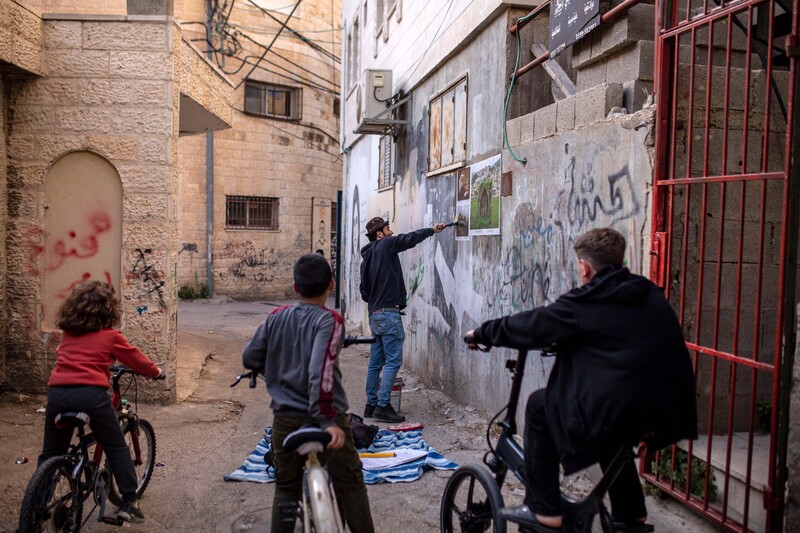
Children look on as al-Bazz puts up his exhibition in Dheisheh refugee camp, Bethlehem.
Refugee camps are full of children with few places to go. They would often gather around the exhibition, and al-Bazz would engage them with questions.
To his surprise, some didn’t know where their families were originally from. Al-Bazz would press them. “Ask your parents!” He would also ask what the Nakba meant or if they had heard of the right of return, the internationally enshrined right of all refugees to be allowed to go back to where they came from.
Many of the children were curious and many knew their origins. But in the refugee camps, the original survivors are dying, and with them an important part of the memories of the Nakba are vanishing.
In his exhibition statement, al-Bazz put it this way:
“The photos should not be viewed as stories about the past — at least not as long as Palestinians are forced to remain refugees, banned from returning to their homes and lands, while any Jewish person from anywhere on the globe has the right to settle on their land and is automatically entitled to Israeli citizenship.”
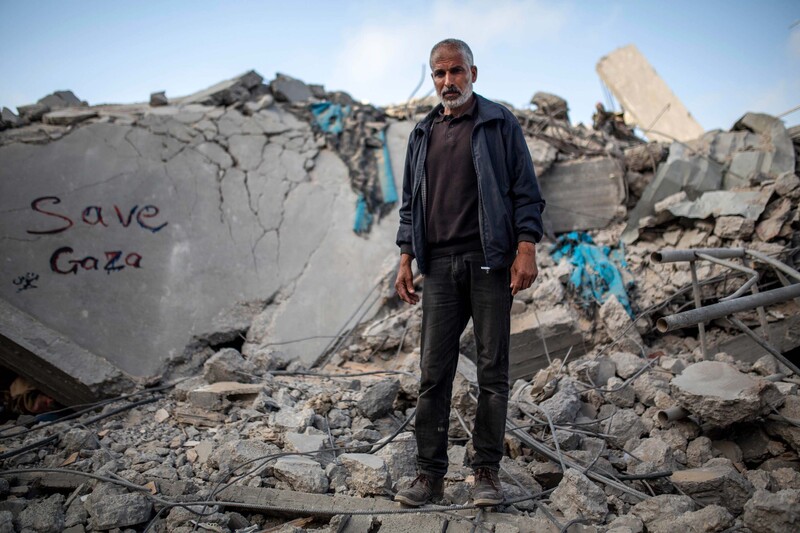
Yahia Abu Obeid stands on what remains of his home in Deir al-Balah in the Gaza Strip. The home, which housed 10 members of three generations of the same family, was bombed on 13 May during Israel’s five-day military assault. It is yet more evidence that the Nakba is ongoing, Abu Obeid, 55, said on 15 May, when Palestinians marked the 75th commemoration of the Nakba.
“The Nakba of 1948 must still be spoken of in the present tense. The process of ethnic cleansing is just done by other means.”
Indeed, Israel’s recent aggression on Gaza is only the latest example of an ongoing process of dispossession and displacement through violence.
In the context of this ongoing Nakba, how do the photos resonate?
The whole point of the work is to shed light on the connection between the past and the present, al-Bazz said. Palestinian liberation, he said, will only happen by addressing and redressing the injustice of the Nakba and the rights of refugees.
“We need to get back to the root of the question. Otherwise it will only be a cosmetic solution.”
He advocates a decolonial approach that rejects the 1967 framework and promotes instead a one-state solution. What is happening between the Jordan River to the Mediterranean Sea, he said, should be properly viewed as a single issue.
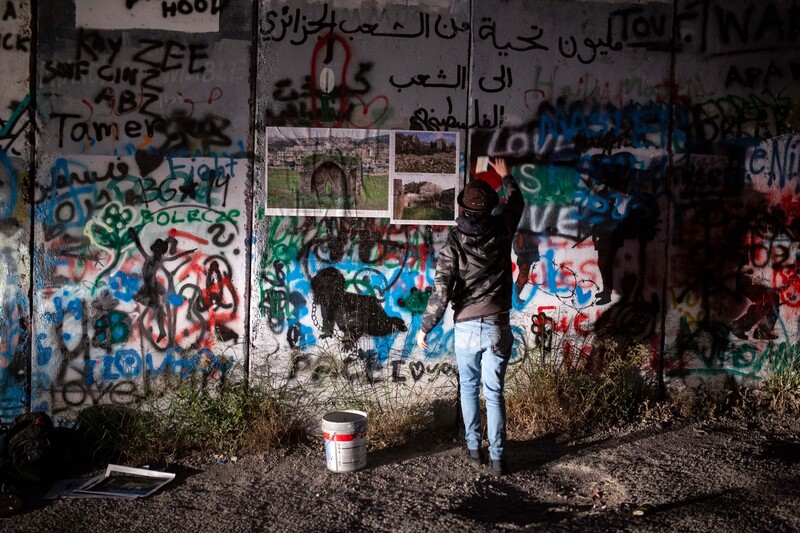
Al-Bazz puts up his exhibit with the help of the lights of his car on the Israeli Annexation Wall in Bethlehem, near the Aida refugee camp.
In his captions, for instance, he uses “Tel Aviv settlement” instead of simply “Tel Aviv,” as is used by mainstream media.
“Why would you not say that Tel Aviv is a settlement? 117,000 out of 120,000 Palestinians in Jaffa and surroundings where Tel Aviv was built were expelled. I will not recognize this settler colonial regime, not at my expense.”
The exhibition, which has also toured Lebanon, Jordan, the UK and the US, can be downloaded here.
Anne Paq is a French freelance photographer and member of the photography collective ActiveStills.


